Abstract
Both the painter of this portrait, Friedrich Overbeck (1789–1869), and its subject, Franz Pforr (1788–1812), were founding members of the Brotherhood of St. Luke, a group of six Vienna Academy students who banded together in 1809 to protest the stultifying routines of academic training. (The other four founding members were Ludwig Vogel, Jospeh Wintergerst, Joseph Sutter, and Franz Hottinger; they were later joined by Peter Cornelius, Wilhelm Schadow, and others.) After the young artists moved to Rome, took up residence in an abandoned monastery, and adopted a self-consciously communal lifestyle that involved dressing in archaic robes and growing facial hair, they were dubbed the “Nazarenes,” the name by which they are most commonly referred today. The Nazarenes took inspiration from the Middle Ages, which they viewed as an era of spiritual purity, unprecedented faith, and intense community. In this and other respects, they were the leading representatives of a much larger and diverse tendency toward medieval revivalism in German painting at the turn of the 19th century. Like many artists and critics—such as Ludwig Tieck and the Schlegel brothers—the Nazarenes were drawn to what they regarded as the simple piety and uncomplicated naturalism of the medieval era. This perceived purity of feeling was seen as corresponding with Romantic longings for a pre-modern unity with the world. Furthermore, in the emerging historical consciousness of the nineteenth century, revivalists understood the power of art to be rooted in the artist’s connection to his immediate locale and its artistic heritage. Such historicism and particularity made the art of the Nazarenes, and other revivalists, the perfect vehicle for German nationalist pride during the Napoleonic wars.
